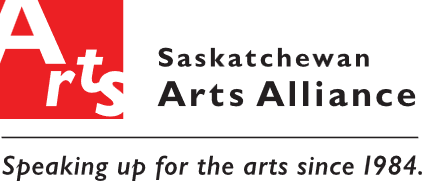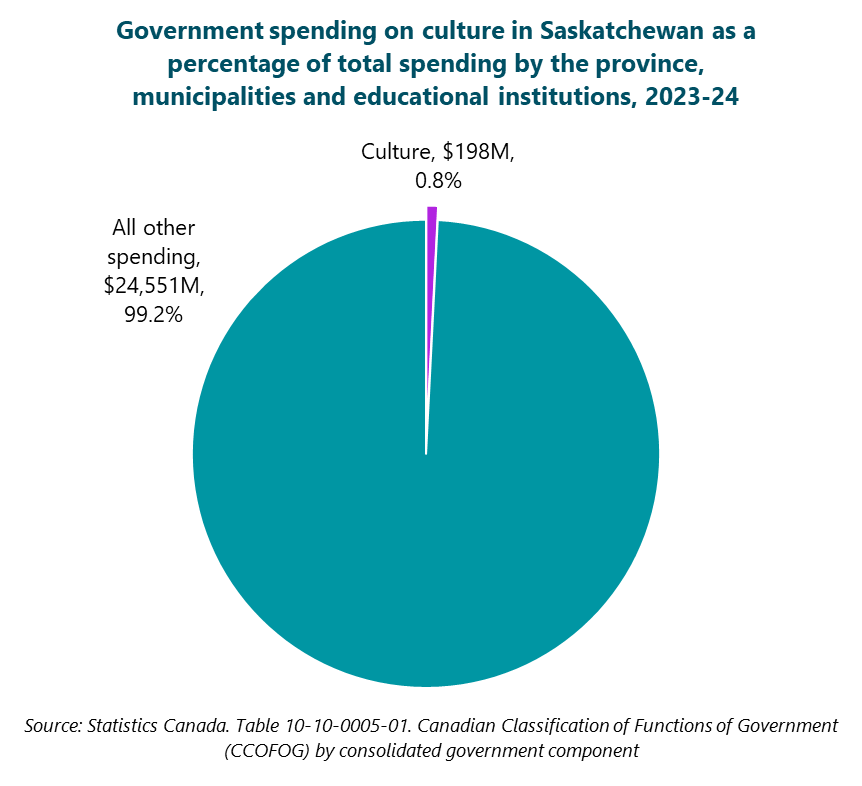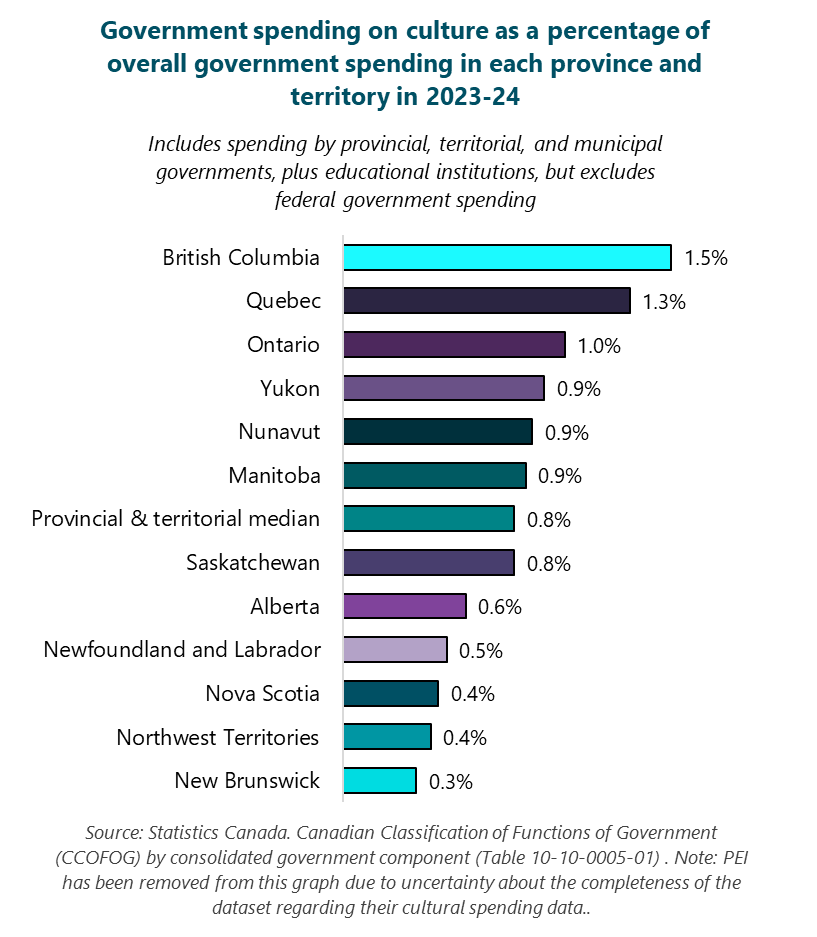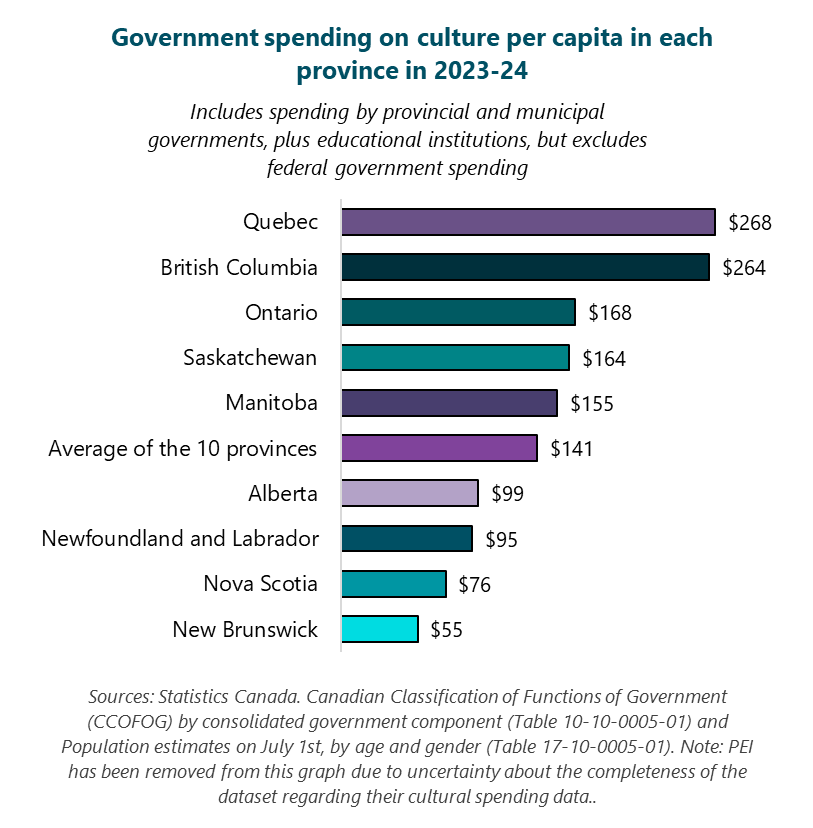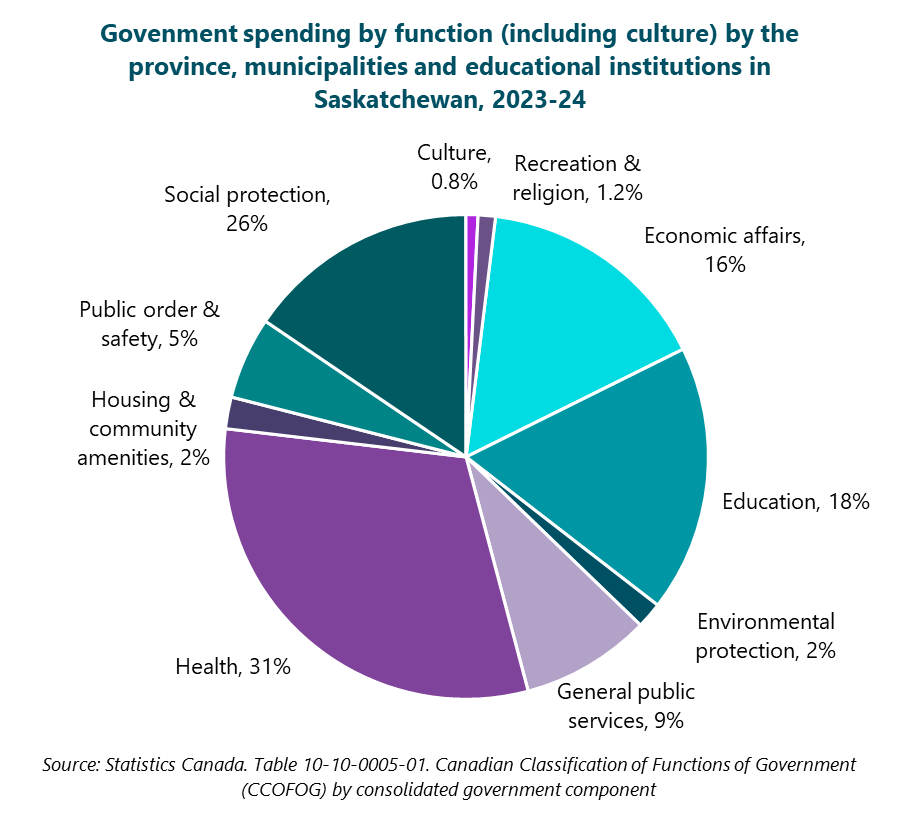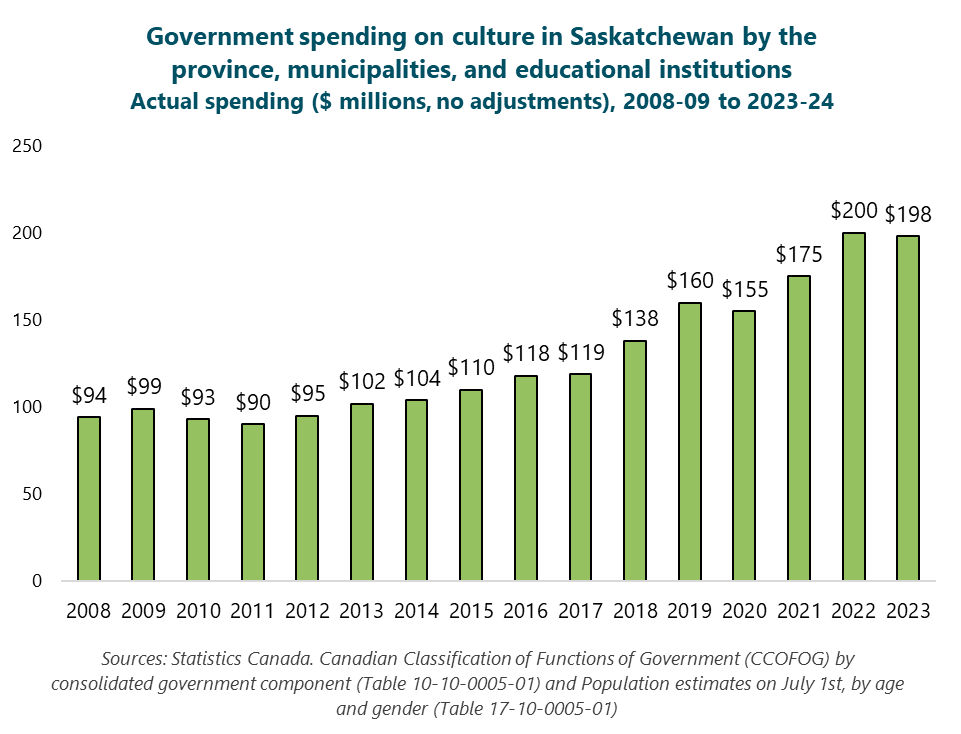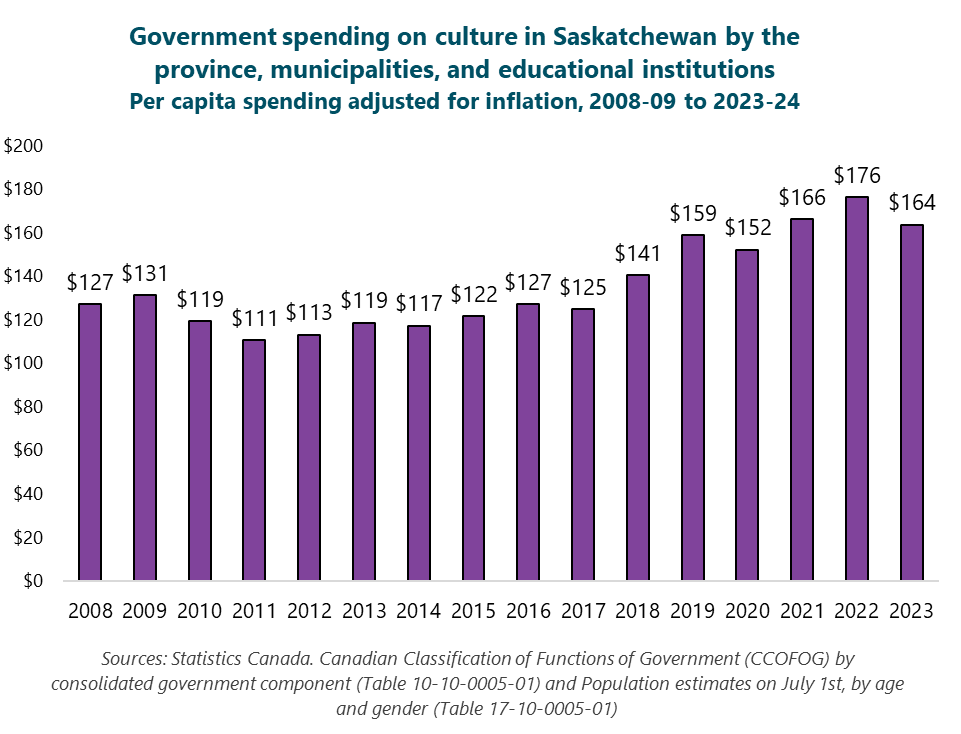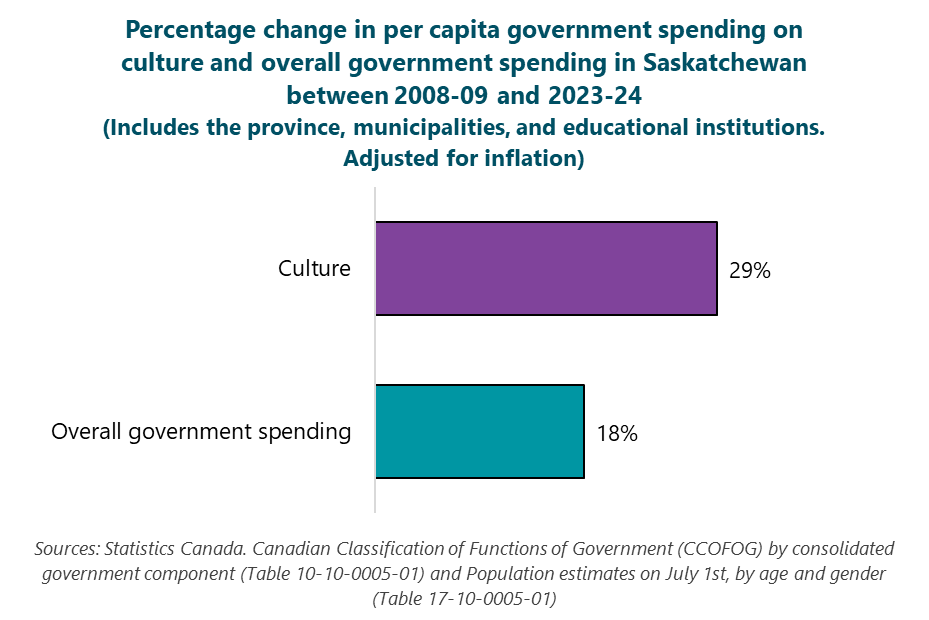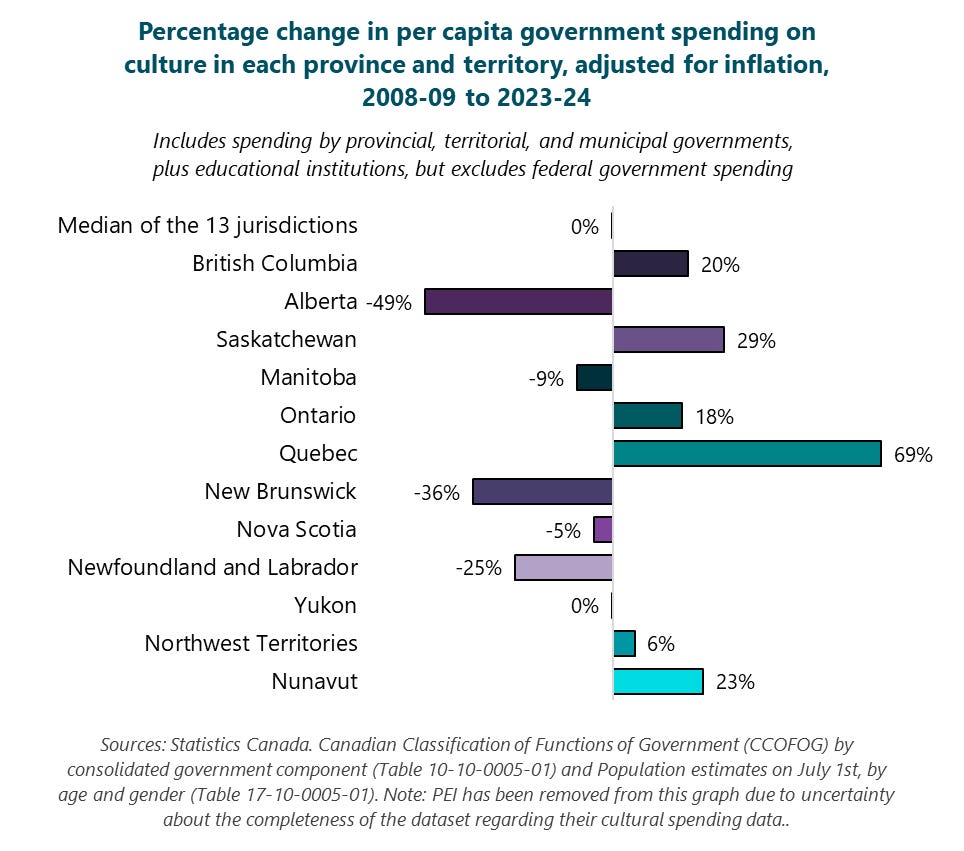Government spending on the arts, culture, and heritage in Saskatchewan
Analysis of current data and historical trends, including per capita spending
A recent analysis by Hill Strategies of spending on the arts, culture, and heritage showed that governments at all levels invested $13 billion on culture in 2023-24. The federal government spent $5.4 billion, or 41% of all government spending on culture in 2023-24. Provinces, territories, municipalities, and educational institutions invested $7.6 billion on culture, representing 59% of all government spending on culture.
This report analyzes spending in Saskatchewan, not just spending by the Province of Saskatchewan. The analysis includes non-federal levels of government and quasi-governmental organizations:
The provincial government and its agencies
Municipal governments and their agencies
Educational institutions
Health care establishments (which likely have little or no direct spending on culture)
The dataset does not offer separate data for each level of government within the province, nor does it allocate federal spending by province. These breakdowns are therefore not possible.
The article was prepared at the request of the Saskatchewan Arts Alliance. Hill Strategies retained analytical independence and editorial control of the content.
The Statistics Canada dataset that underpins this report offers two categories that fit within a typical statistical definition of the arts, culture, and heritage: 1) broadcasting and publishing services; and 2) culture, excluding broadcasting and publishing. For Saskatchewan, Statistics Canada did not identify any spending on broadcasting and publishing. All of the cultural funding in the province falls under the second category (which the dataset calls “cultural services”).
There is a combined category for “recreation, culture, and religion, not elsewhere classified” that might include some cultural spending. In 2023-24, there was $38 million in government spending in Saskatchewan in this category, compared with $198 million in the other two cultural categories. The amounts that are “not elsewhere classified” have not been included in the calculations of government spending on culture, because there is no way of knowing the cultural proportion of this spending. To better understand the potential magnitude of this spending, we could assume that spending on culture represents one-half of the not-elsewhere-classified category. In this case, total spending on culture would be $19 million or 10% higher than the total amount reported in this report. The amounts in the not-elsewhere-classified category have decreased over time. If some of this spending was cultural, earlier estimates would be higher, and the change over time would be lower.
For each element of government spending, the data include direct government support, not tax credits or other indirect instruments. Because of these accounting methods in the dataset, the 2012 elimination of the Saskatchewan film tax credit would not show as a reduction in government support, but the 2022 creation of the film production grant would appear as an increase in support.
The 2023-24 data are labeled as “preliminary” and may therefore be adjusted in the next update of the dataset.
The data source and other important notes are included at the end of this report.
Government spending on culture represents 0.8% of government spending in Saskatchewan
In 2023-24, the province, municipal governments, and educational institutions in Saskatchewan spent $198 million on culture, which represents less than one percent of total government spending in the province, as shown in the following graph.
Culture’s proportion of government spending: Comparison with other provinces
In the provinces and territories, governments typically spent 0.8% of their total expenditures on culture in 2023-24. Saskatchewan is the median jurisdiction, ranking seventh out of the 13 provinces and territories. As shown in the following graph, governments in B.C. spent the most as a percentage of total spending in 2023-24 (1.5%), followed closely by governments in Quebec (1.3%).
Per capita spending on culture: Comparison with other provinces
The $198 million invested in culture in Saskatchewan in 2023-24 represents $164 per resident, ranking fourth among the 10 provinces. The median spending on culture by non-federal levels of government was $127 per capita in 2023-24. Governments in Quebec spent the most per capita ($268), followed closely by governments in British Columbia ($264).
The following graph depicts the per capita spending level in each province.
Government spending on culture in Saskatchewan compared with other economic sectors
The $198 million spent on culture in Saskatchewan is lower than the amount that governments spent on recreation, sports, and religion ($285 million). The following graph shows that spending on culture is much lower than government spending in many other areas. For example, government investment in the category of economic affairs was $3.9 billion in 2023-24, which is 20 times larger than the investment in culture. Within this category, government spending on agriculture, forestry, fishing, hunting ($2.6 billion) is 13 times larger than spending on culture. The economic affairs category also includes spending on transport, fuel, energy, mining, manufacturing, construction, and others.
Trends in government spending on culture in Saskatchewan
Government spending on the arts, culture, and heritage in Saskatchewan increased from $94 million in 2008-09 to $198 million in 2023-24, an increase of 111% before adjusting for inflation and population growth, as shown in the following graph.
The following data have been adjusted for both inflation and population growth (sometimes called “real, per capita changes”).
As noted above, the $198 million spent on culture by the province, municipalities, and educational institutions in 2023-24 equals $164 per resident. After adjusting for inflation and population growth, this is a 29% increase from the $127 spent in 2008-09.
The following graph highlights the changes in cultural spending in Saskatchewan between 2008-09 and 2023-24, after adjusting for inflation and population growth. Government spending on culture reached its peak in 2022-23 ($176 per person) and was at its lowest point in 2011-12 ($111 per person).
Between 2008-09 and 2023-24, overall spending by the province, municipalities, and educational institutions in Saskatchewan increased from $17,411 to $20,465 per capita (adjusted for inflation). The 18% increase in overall government spending is lower than the 29% increase in government spending on culture, as depicted in the following graph.
The larger increase in cultural spending did not have a significant effect on the proportion of overall government spending allocated to culture, which was 0.7% of total spending in 2008-09 and 0.8% in 2023-24.
Changes in real, per capita spending on culture: Comparison with other jurisdictions
Among the provinces and territories, there has been no consistent pattern in real, per capita spending on culture over the past 15 years, as shown in the following graph. Yukon is the median jurisdiction in this regard, with no change in cultural spending since 2008-09. Saskatchewan is one of the jurisdictions with the largest percentage increases between 2008-09 and 2023-24: Quebec (69%), Saskatchewan (29%), Nunavut (23%), and British Columbia (20%).
Sources and notes
Statistics Canada. Table 10-10-0005-01. Canadian Classification of Functions of Government (CCOFOG) by consolidated government component, https://www150.statcan.gc.ca/t1/tbl1/en/tv.action?pid=1010000501
The inflation and per capita calculations were made using data from Consumer Price Index, annual average, not seasonally adjusted and Population estimates on July 1st, by age and sex.
The province, local governments, and educational institutions
The dataset contains just two categories of government levels, and this report analyzes cultural spending by the province, local governments, and educational institutions. The database refers to this grouping as “Consolidated provincial-territorial and local governments”, which include “provincial and territorial governments, health and social service institutions, universities and colleges, municipalities and other local public administrations, and school boards.” Breakdowns within this category are not available in the dataset. We cannot separate spending by the province from local governments and educational institutions: all are included in the same broad category.
Cultural categories
The dataset describes the two cultural categories and the “not elsewhere classified” category as follows:
Culture, excluding broadcasting and publishing (what Statistics Canada calls “cultural services”). This covers much of what we would usually consider to be funding for the arts, culture, and heritage. Definition: “This group covers provision of cultural services; administration of cultural affairs; supervision and regulation of cultural facilities; operation or support of facilities for cultural pursuits (libraries, museums, art galleries, theatres, exhibition halls, monuments, historic houses and sites, zoological and botanical gardens, aquaria, arboreta, etc.); production, operation, or support of cultural events (concerts, stage and film productions, art shows, etc.); and grants, loans, or subsidies to support individual artists, writers, designers, composers, and others working in the arts or to organizations engaged in promoting cultural activities.”
Broadcasting and publishing services. Definition: “This group covers administration of broadcasting and publishing affairs; supervision and regulation of broadcasting and publishing services; operation or support of broadcasting and publishing services; grants, loans, or subsidies to support the construction or acquisition of facilities for television or radio broadcasting; the construction or acquisition of plant, equipment, or materials for newspaper, magazine, or book publishing; the production of material for, and its presentation by, broadcasting; the gathering of news or other information; and the distribution of published works.”
Recreation, culture, and religion, not elsewhere classified. Definition: “This group covers administration, operation, or support of activities such as formulation, administration, coordination, and monitoring of overall policies, plans, programs, and budgets for the promotion of sport, recreation, culture, and religion; preparation and enforcement of legislation and standards for the provision of recreational and cultural services; and production and dissemination of general information, technical documentation, and statistics on recreation, culture, and religion.”
We cannot break down the two key cultural categories (into, say, spending on “the arts”). Data for all three categories are also rolled up into a broader category for spending on “recreation, culture, and religion”.
Yearly data cutoffs
The provincial government operates on a fiscal year that ends in March. Spending for the fiscal year is allocated to the calendar year containing the first nine months of the fiscal year, not the year in which the fiscal year ended. In other words, spending in fiscal 2023-24 is published as spending in 2023. The data released in late November of 2024 cover the fiscal year ending March 31, 2024.



